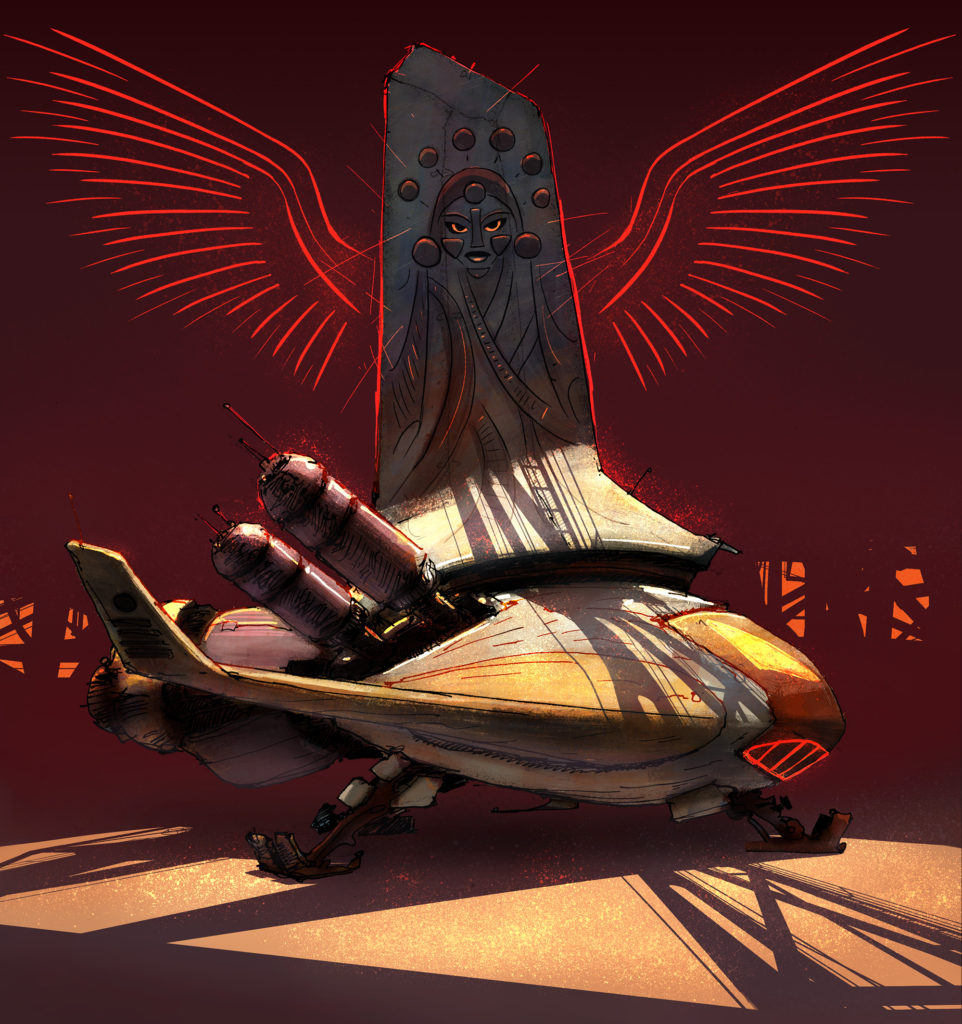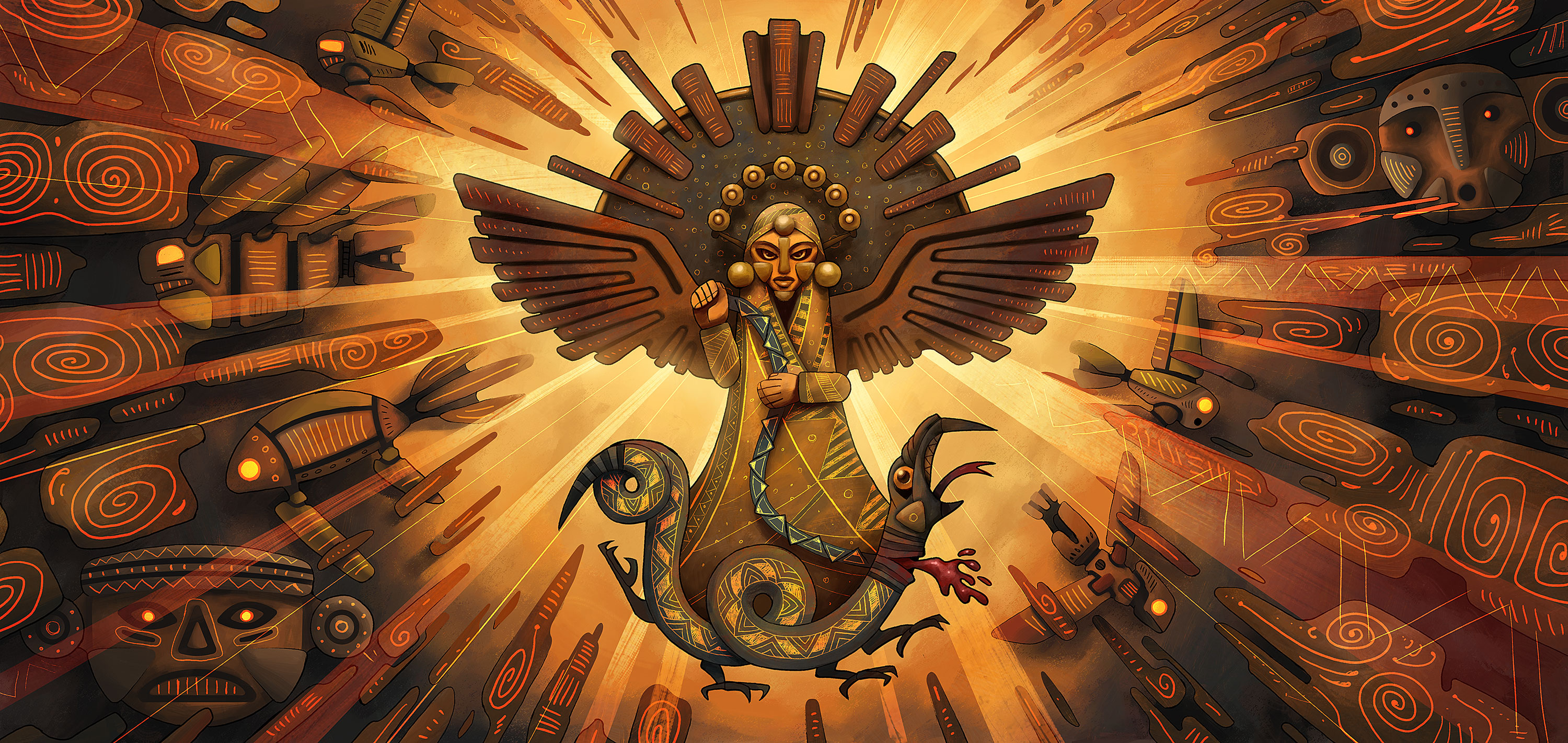Andean Sky is an interactive web-comic about an immigrant who returns to his home-country Ecuador, in South America, to reconnect with his own culture. With this project I am dealing with themes of identity, religion and technology projected into the future within the Latin American context. This project is my MA thesis in Illustration at the Interactive Design Institute. Andean Sky is available for free and it can be displayed on PC, iOS and Android at www.carlosvk.info/andeansky
Science Fiction in Latin America
Latin America has been producing science fiction since colonial times but unfortunately this creative output has been widely ignored. Although Latin America does have a presence in western science fiction today, it is often represented with negative stereotypes. Speaking Spanish and having a darker skin colour is equivalent of being undeveloped, delinquent or a victim. If science fiction is about imagination and invention, is it possible to challenge stereotypes as well? The answer does not have to come from western science fiction; Latin America is well capable of producing its own science fiction work. In fact, the genre is not new in Latin America. Its roots can be traced long before the genre was even defined in the US and Europe. In 1775 Franciscan friar Manuel Antonio de Rivas, in colonial Mexico, wrote one of the first works on record that we can recognise today as science fiction. His tale describes a man’s “voyage to the Moon and his encounter with an advanced lunar society.” Rivas’ work was also critical about the political scene in Mexico at the time, and as a result, he was threatened to be charged by the Holy Inquisition for heresy in several occasions. His novel was banned and lost for almost two centuries. Despite dictatorships or economical strains, South America had a considerable output of science fiction work but it wasn’t until the second half of the 20th century that it began to be recognised for it.
Ecuador as Inspiration for Science Fiction and Design
Ecuador is a country in South America which holds a multicultural population and diverse natural ecosystems. The Yasuní National Park alone holds more species of animals, insects and plants than the entire European continent and North America combined. From the perspective of a visual designer, the Yasuní is an endless inspirational pool of forms, shapes and colours. Yet, despite this diversity, there is little attention to this part of the world and there is no interest from the international community, or the national government, of saving it from destruction by the oil industry.

Image Credits: Cóndor, Frog by Nicolas Villarreal, Frailejon.
Before the Inca conquest, and later the Spanish conquest, the region that is today Ecuador was home to a diversity of cultures and communities. These cultures might not seem “magnificent” in comparison to the Aztec or the Inca civilisations, perhaps because many lacked big scale projects such as pyramids, but they did achieved important advancements in art and technology. For instance, the Tolita and La Tumaco cultures in the northern coastal area produced ceramics so detailed that scientists have been able to recognise age, specific diseases and birth defects through them. They also developed some of the most sophisticated methods of metallurgy in the entire South American continent by perfecting a platinum-gold alloy which was not achieved even by civilisations like the Inca or the Aztec.

Image Credits: Ancestral Female Figure, INTI God Mask, Figure Vessel.
Looking into the Future: Utopian Ecuador.
“The historic alternatives to capitalism have been proven unviable and impossible… Utopian form is itself a representational meditation of radical difference”
Fredric Jameson – Archaeologies of the Future.
I imagine the future of Ecuador to be technologically advanced. Being a country that lies on steep and irregular land I envision its future in the skies and off the ground. Why travel by road when you can fly through the clouds? This is not fiction; today cities like Medellin (Colombia) or La Paz (Bolivia) have sky lift metro systems that provide public transport to geographically isolated neighbourhoods.

Image Credits: Cotopaxi, Metro Cable, La Virgen del Panecillo.
I want to imagine that aircrafts powered by clean energy will provide efficient transport in Ecuador. It would dramatically change urban design and social behaviours. Just imagine how different our world would look like today if we were running on solar power instead of fossil fuel. It could have happened; solar power technology has been available as early as 1912. Imagine if Nikola Tesla, one of the great minds of our time, would have been successful in providing free wireless power for the world. How different our world would look like today.

The culture of transport in Latin America has a unique identity already, and it is closely related to religious identity. Identity is an integral part of car culture and in this case it is expressed through elaborate works of art which often feature religious figures, passages and even modern miracles. The Virgin of El Quinche has performed multiple miracles and sometimes these miracles are celebrated with allegorical art displayed on buses or trucks. Blessings of vehicles is also a common practice in South America.

“Birds are associated with the ‘heavenly’ as well as the earthly … beyond mortal life”
Adrian Frutiger – Signs and Symbols.
Religion is a strong cultural identity that can flourish despite technological progress. In 2016 a devastating magnitude 7.8 earthquake in the northern coastal region of Ecuador destroyed entire cities and shocked the nation. Technology was at the forefront during this crisis. Utilising social media and open source data, local Developers created digital tools that communicated the rescue-aid teams with the affected communities on the coast and documenting the damages. At the same time, one of the leading newspapers in Ecuador, El Comercio, published an article documenting how a statue of the Virgin Mary survived the collapse of the building in which it was hosted, and further speculating if this was the work of a miracle. In our modern era we are quite capable of believing in miracles and constructing mythologies surrounding them. During the 1990s a group of researchers from the University of Georgia documented how a group of people constructed tales and visual symbols to validate the apparitions of the Virgin Mary in the US town of Conyers.

“The mythological figure of the Universal Mother imputes to the cosmos the feminine attributes of the first, nourishing and protecting presence”
Joseph Campbell – The Hero with the Thousand Faces.
My designs have been inspired from the Ecuadorian nature and heritage. The result from the encounter of technology and religion has led me to re-define current religious figures and establish new ones. In my images I have used symbols taken from Christian colonial art, pre-Columbian art and “advanced technology”. The illustration of The Winged Madonna of Quito, for example, features the Virgin Mary with wide open wings defeating Lucifer who is represented by a snake. The image is borrowed from the book of Revelations (12:1 – 18) from the Christian Bible. In my image, aircrafts are flying through the clouds under her command. The image is decorated with pre-Columbian patterns and shapes. She is the protector of the skies.
An Interactive Comic
Andean Sky is the story of Washington (Washi) Toapanta (a common name in Ecuador), an immigrant young man who returns to his home country Ecuador with the intention to stay and reconnect with his roots and his mother Gloria. Washi will need to accept the Ecuadorian culture in order to achieve his goal. Religion is the central piece of the conflict in this story because it represents the reason why Washi struggles to achieve this goal. Washi is not a religious person but Gloria is, and this creates tension between the two.

My first idea was to create an App for mobile but after researching various technologies I decided to create a website instead. HTML5 is cross-platform and it is also free, which allows my product to be easily sharable. I spent some time figuring out how to accommodate one web page for all screen orientations. The comic is designed to be viewed on landscape mode. This is not an issue when displayed on PC but it was challenging to design the user experience when displayed on portrait mode on mobile. I feel that I created a simple solution for the user: an icon that sits at the bottom of the page only to be revealed when the screen is on portrait mode. Based on focus testing I am satisfied to see that people understood what to do in order to read the comic.
My goal for the user experience (UX) was to create a simple user-controlled-animation system that would not interfere with the content. I decided early on that the interactivity for the comic should not become more important than the comic itself. The newest HTML5 combined with old-school animated GIFs and PNGs provided the perfect solutions that I was looking for. The scrolling-animation effect is simple and clean but also rewarding to look at.
Final Thoughts
Andean Sky is not an attempt to define neither what is culture nor what is religion. My intention with Andean Sky is to acknowledge that culture has many faces and some are more significant than others. Being an immigrant myself I believe that my perspective about Ecuador, where I grew up and lived, has become my own. Andean Sky is a reflection about my identity as an immigrant and as an artist.
Andean Sky was selected Semifinalist at the 2016 Adobe Design Achievement Awards in the Fine Art – Illustration category.
You can read the comic here carlosvk.info/andeansky
If you are interested on exploring the development process here are some links to check out:
https://www.carlosvk.info/andeansky/presentation/index.html
https://www.carlosvk.info/andeansky/prologue/indexOLD.html
https://carlosvk.info/andeansky/_storyboard/
https://carlosvk.info/andeansky/_storyboard-pass1/
https://carlosvk.info/andeansky/_storyboard-pass2/
https://carlosvk.info/andeansky/_lineart/
https://carlosvk.info/andeansky/_colorpass/
https://carlosvk.info/andeansky/_street/


